江苏中职英语第一册UNIT 1教案
- 格式:doc
- 大小:85.00 KB
- 文档页数:13
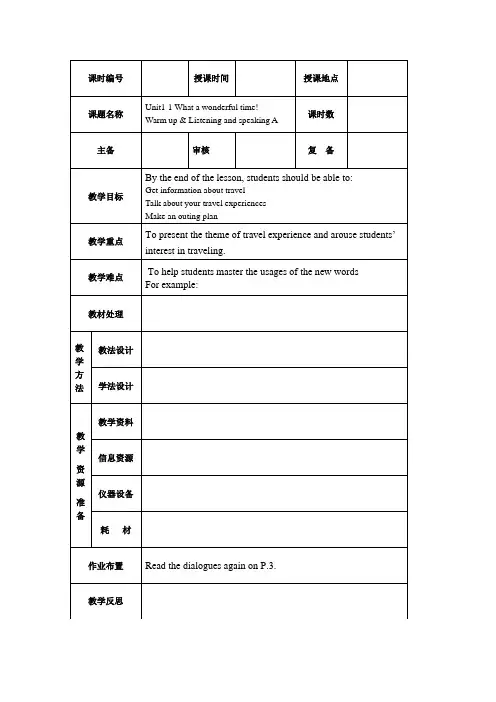
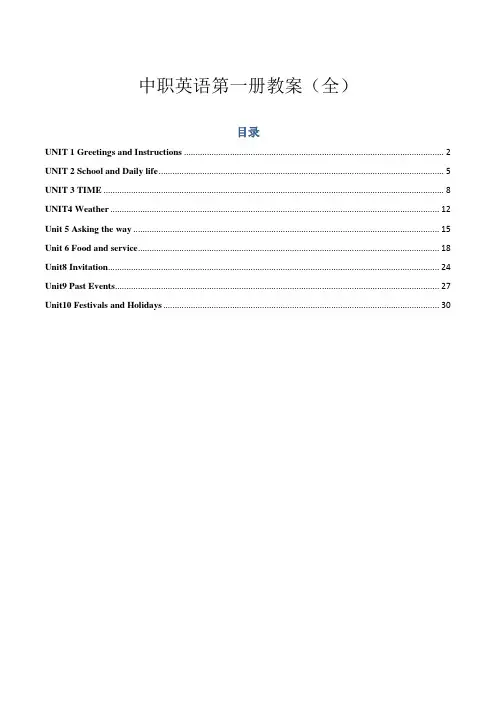
中职英语第一册教案(全)目录UNIT 1 Greetings and Instructions (2)UNIT 2 School and Daily life (5)UNIT 3 TIME (8)UNIT4 Weather (12)Unit 5 Asking the way (15)Unit 6 Food and service (18)Unit8 Invitation (24)Unit9 Past Events (27)Unit10 Festivals and Holidays (30)UNIT 1 Greetings and Instructions一、词汇(课本14页)1. addresspostal addresspostal adj. 邮政的2. bossThis is my boss.worker3.call【教材原文】Please call me Jianjun.请叫我建军好了。
①.命名,把…叫作call sb.sthMay I have your name?call me Tom.叫我汤姆吧。
②call on sb.拜访某人call at sp.拜访某地(3)打电话call sb.(up)给某人打电话I’ll call you this evening.今晚我将给你打电话。
(4)m.电话give sb. a call 2给某人打电话make a phone call打电话This is my friend Mary (call)4. computer5. customer6. e-mail7. greet 打招呼,问好greeting n.问候(通常用复数)【教材原文】Can you greet people in English? 你会用英语打招呼吗?greet each other彼此问候、彼此打招呼We greet each other with smile.我们微笑着彼此打招呼。
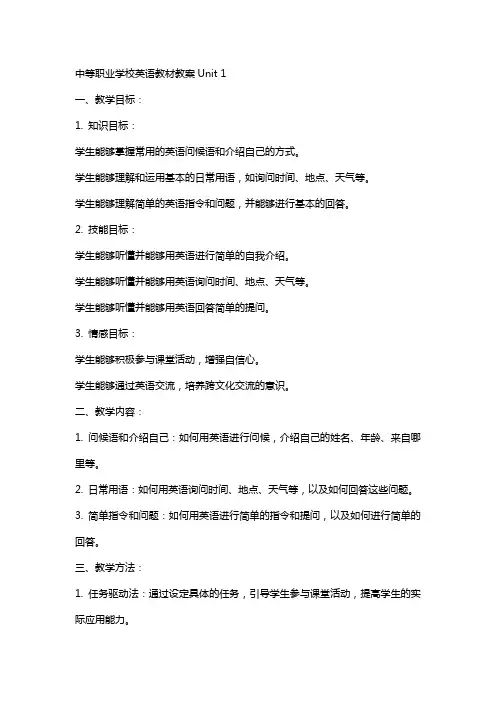
中等职业学校英语教材教案Unit 1一、教学目标:1. 知识目标:学生能够掌握常用的英语问候语和介绍自己的方式。
学生能够理解和运用基本的日常用语,如询问时间、地点、天气等。
学生能够理解简单的英语指令和问题,并能够进行基本的回答。
2. 技能目标:学生能够听懂并能够用英语进行简单的自我介绍。
学生能够听懂并能够用英语询问时间、地点、天气等。
学生能够听懂并能够用英语回答简单的提问。
3. 情感目标:学生能够积极参与课堂活动,增强自信心。
学生能够通过英语交流,培养跨文化交流的意识。
二、教学内容:1. 问候语和介绍自己:如何用英语进行问候,介绍自己的姓名、年龄、来自哪里等。
2. 日常用语:如何用英语询问时间、地点、天气等,以及如何回答这些问题。
3. 简单指令和问题:如何用英语进行简单的指令和提问,以及如何进行简单的回答。
三、教学方法:1. 任务驱动法:通过设定具体的任务,引导学生参与课堂活动,提高学生的实际应用能力。
2. 情景教学法:通过创设真实的语境,让学生在实际情境中学习和使用英语。
3. 互动教学法:通过教师与学生、学生与学生之间的互动,激发学生的学习兴趣和积极性。
四、教学步骤:1. 热身活动:教师与学生用中文进行简单的自我介绍,引导学生用英语进行自我介绍。
2. 教学新知识:教师展示一些常用的英语问候语和介绍自己的方式,引导学生进行学习和模仿。
3. 实践环节:教师创设一些实际情境,如询问时间、地点、天气等,让学生进行实际操作和练习。
4. 总结和反馈:教师对学生的表现进行总结和评价,鼓励学生积极参与课堂活动。
五、课后作业:1. 复习本节课所学的英语问候语和介绍自己的方式。
2. 练习用英语询问时间、地点、天气等,并能够进行回答。
3. 准备下一节课所需带的教材和资料。
中等职业学校英语教材教案Unit 6六、教学目标:1. 知识目标:学生能够掌握有关日常生活中的常见场景的英语表达方式,如餐厅、医院、机场等。
学生能够理解和运用基本的英语句子结构,如主语+谓语+宾语。
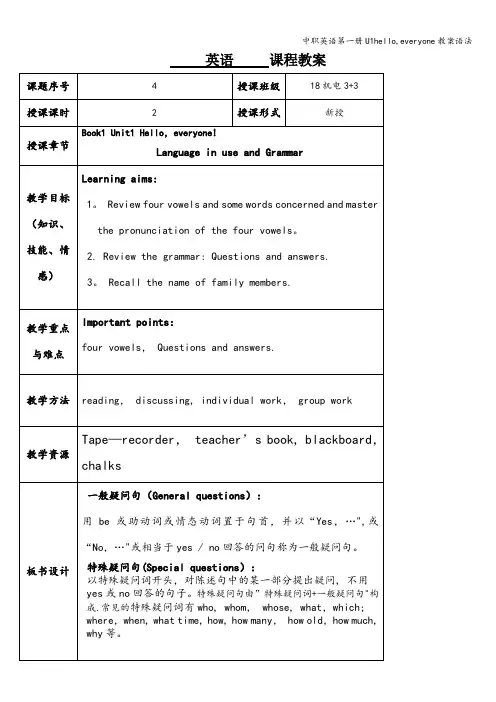

江苏中职英语第一册U N I T-1教案-CAL-FENGHAI-(2020YEAR-YICAI)_JINGBIANUnit 1 Listening & SpeakingI.Warm-up1.At the beginning of the class, say hello to several students torecall the common expressions of greeting.2.Let the students complete the conversations in Activity 1 andpractice in pairs, guessing the relationship between thosespeakers. (Pic 1: Teacher & Student, Pic 2 : Schoolmates orClassmates, Pic 3: Mother & Daughter, Pic 4: Doctor & Patient ) 3.Ask the students how to address their teacher in the usual way.Then lead in the content of Activity 2, role-playing theconversation in pairs.II.Listening and SpeakingA.Nice to Meet You!1.Let the class guess the relationship between the two studentsin Activity 1 after listening to the record of a conversationwithout opening their textbooks.2.Listen to the conversation again and underline those sentencesabout greetings and introductions.3.Require the students to read the conversation after the videoone sentence after another. And then make clear the main idea about the conversation. Practice the conversation in pairs.24.Brainstorming. Think about as many expressions on introducingyourself and relevant responses as possible. Then use thoseexpressions to introduce each other in groups, referring to the short dialogue in Activity 3.plete the conversation in Activity 4 to consolidate whatyou’ve learnt about greeting and introduction. Choose somegroups to act out the conversation in class.B.Let Me Introduce Myself!1.Listen to a song called My Name is Xiao Shenyang.2.Ask one student to introduce himself or herself, and then letthe rest think over what information they should give out when making a self-introduction.3.Talk about the different expressions between Chinese nameand English name.4.Go through key words in Activity 5 and finish Activity 6 & 7 bylistening to the record of the speech twice.5.Let the students guess the meaning of the girl’s name in thespeech. And then choose some students to narrate the reason of their name.6.Design a student ID of your partner by asking him or her thequestions occurring in Activity 8. Then invite some students to3make a self-introduction before class according to the student ID made by their partner.7.Exercises about listening and speaking.III.Further Reading1.Brainstorming. Ask the students to list various methods ofgreeting others in other countries. If possible, make gestures to explain it clearly.2.Scan the passage in Further Reading, and choose someone toretell the main idea of the text. Try to act out each way ofgreeting when narrating.3.Read the whole passage after the record loudly.IV.Assignment1.Practice listening model dialogues.2.Write a short passage to introduce yourself in class.3.Preview Words and Expressions in Reading.4Unit 1 Reading & WritingI.Revision1.Review model dialogues in Listening and Speaking section byasking some pairs of students to act out those dialogues in class.2.Choose some students to speak out their self-introduction infront of the class. Let the rest elect the best among them.II.Lead-in1.Ask the students to answer the question What do you like best?in order to lead in the topic of the reading passage. Name a list of things they like, such as food, books, clothes, or other things.2.By what do you address those who like food best? Let’s firstwatch a video to find out the answer. (gourmet 美食家,food lover 吃货)III.Reading1.Now we will meet such a food lover called Jenny today.Although she likes the food best, she spends her money on all aspects in a reasonable way. Then how does Jenny spend hermoney2.5Ask the students to write each category in the correct place in the pie chart after listening to the record of the text.3.Reading the passage after the record and try to find out theanswer to the questions in Activity 3.4.Learn the words and expressions related to the text. Read themfluently and try to recite them.spend…on 花费…在…go to the movie 看电影mobile phone 手机text message 短信息save up 储蓄,存钱5.Study the text one paragraph after another. Pay specialattention to those set phrases and key sentence patterns. Read the text together again so as to understand its theme.It’s great to see all of you. 见到大家很高兴。
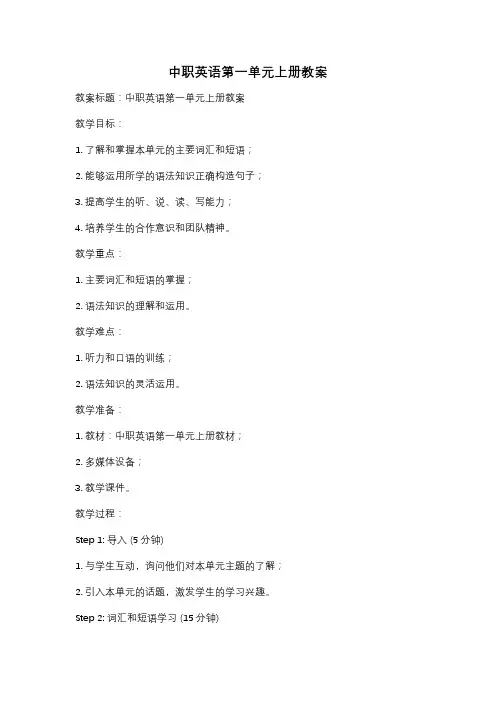
中职英语第一单元上册教案教案标题:中职英语第一单元上册教案教学目标:1. 了解和掌握本单元的主要词汇和短语;2. 能够运用所学的语法知识正确构造句子;3. 提高学生的听、说、读、写能力;4. 培养学生的合作意识和团队精神。
教学重点:1. 主要词汇和短语的掌握;2. 语法知识的理解和运用。
教学难点:1. 听力和口语的训练;2. 语法知识的灵活运用。
教学准备:1. 教材:中职英语第一单元上册教材;2. 多媒体设备;3. 教学课件。
教学过程:Step 1: 导入 (5分钟)1. 与学生互动,询问他们对本单元主题的了解;2. 引入本单元的话题,激发学生的学习兴趣。
Step 2: 词汇和短语学习 (15分钟)1. 通过多媒体展示和教师示范,教授本单元的主要词汇和短语;2. 学生跟读、模仿,巩固词汇和短语的发音和用法。
Step 3: 语法知识讲解 (15分钟)1. 通过多媒体和教师讲解,介绍本单元的语法知识;2. 通过例句和练习,帮助学生理解和掌握语法规则。
Step 4: 听力训练 (20分钟)1. 播放录音,让学生听取相关对话或文章;2. 学生根据听到的内容回答问题,提高听力理解能力。
Step 5: 口语练习 (20分钟)1. 学生分组进行口语练习,模拟真实情境对话;2. 教师巡回指导和纠正学生的口语表达。
Step 6: 阅读和写作训练 (20分钟)1. 学生阅读与本单元相关的文章或短文;2. 学生根据所学内容进行写作练习,如写一篇关于自己的介绍。
Step 7: 总结和反馈 (10分钟)1. 教师对本节课的学习内容进行总结;2. 学生针对本节课的学习进行反馈和提问。
Step 8: 作业布置 (5分钟)1. 布置相应的课后作业,如完成练习册的相关练习;2. 鼓励学生自主学习,提供相关学习资源。
教学延伸:1. 鼓励学生积极参与课堂活动,提高英语口语表达能力;2. 创设多样化的教学环境,激发学生的学习兴趣;3. 鼓励学生进行小组合作,提高合作意识和团队精神。
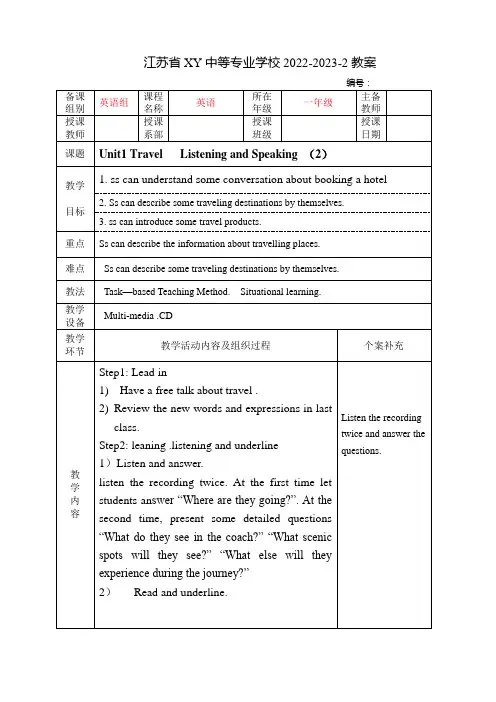

英语课程教案课堂教学安排Activity 3: Use the expressions you've learned to introduce youself to your partner.A: Hi! Mv name is ・B: Nice to meet you. My name's ・A: Nice to meet you, too.Activity 3: Work in groups of three and complete the conversation belowYou and your friend are at a party, and you see the star singer in your school, Sally.You: Hi! You must be Sally.Sally: Yes, I am. Nice to meet you.You: , too. Um . And this is mv friend・Friend: Hello! My name's ・Sally: Fm sorry. Could you .Friend: It's ・Sally: . Got it!You: We,ve heard so much about you, Sally!(The teacher shows the expressions on the screenUse the expressions you've learned to introduce youself to your partner.before the class.)Activity 4: Ask the students to talk about their travel experiences in pairs. Step5: SummaryThe teacher should conclude how to introduce someone about the greeting experiences and the possible responses.Step6:Homework1 Work in groups of three and complete the conversation.2. Make a dialogue by using the useful expressions ・The teacher should conclude how to introduce someone about thegreeting experiences and the possible responses.教学后记。
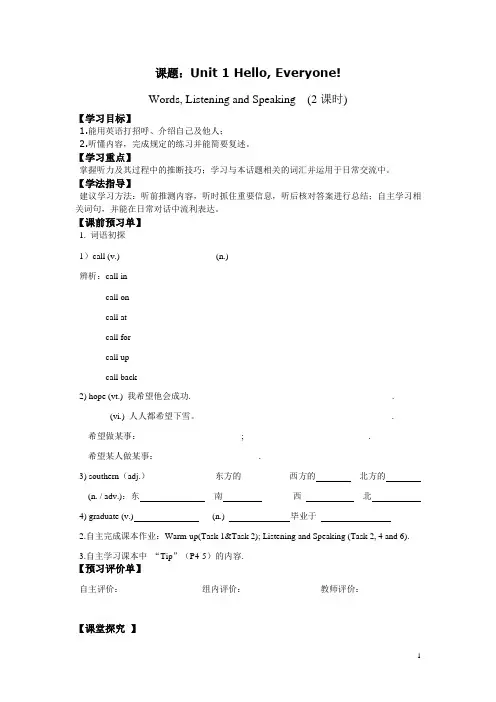
课题:Unit 1 Hello, Everyone!Words, Listening and Speaking (2课时)【学习目标】1.能用英语打招呼、介绍自己及他人;2.听懂内容,完成规定的练习并能简要复述。
【学习重点】掌握听力及其过程中的推断技巧;学习与本话题相关的词汇并运用于日常交流中。
【学法指导】建议学习方法:听前推测内容,听时抓住重要信息,听后核对答案进行总结;自主学习相关词句,并能在日常对话中流利表达。
【课前预习单】1. 词语初探1)call (v.)___________________ (n.)_____________________辨析:call incall oncall atcall forcall upcall back2) hope (vt.) 我希望他会成功.______________________________________________.(vi.) 人人都希望下雪。
___________________________________________.希望做某事:_______________________; ____________________________.希望某人做某事:_______________________.3) southern(adj.)_____________ 东方的_________ 西方的北方的(n. / adv.):东南西北4) graduate (v.) ____ (n.) 毕业于2.自主完成课本作业:Warm-up(Task 1&Task 2); Listening and Speaking (Task 2, 4 and 6).3.自主学习课本中“Tip”(P4-5)的内容.【预习评价单】自主评价:_______________ 组内评价:_________________ 教师评价:______________ 【课堂探究】问题探究:1.You’re a new student, aren’t you?2. You must be Sally, _______________? (写出该句的反义疑问句)知识链接:反义疑问句的基本结构:反义疑问句的几种特殊情况:1)当陈述部分有否定意义的词时:2)含有think, believe, suppose, imagine, expect等动词后接宾语从句构成的主从复合句在构成反义疑问句时:3)祈使句的反义疑问句:4)当陈述部分有情态动词must时:拓展练习:完成句子1) —She doesn’t work in that factory,? (是吗?)—.(是的,她不在。
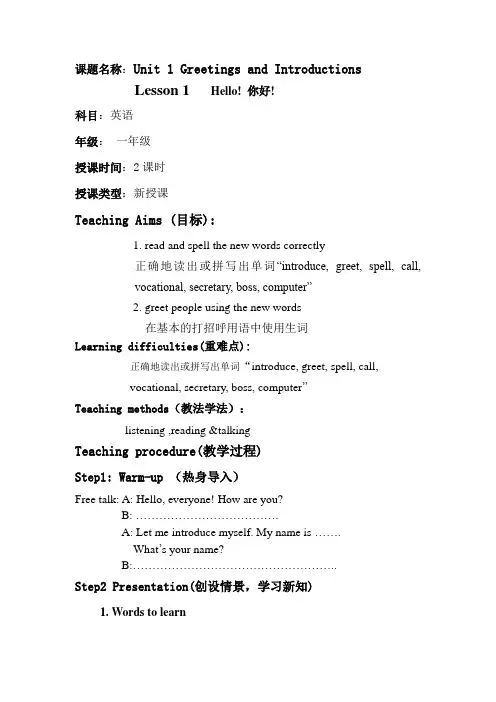
课题名称:Unit 1 Greetings and IntroductionsLesson 1Hello! 你好!科目:英语年级:一年级授课时间:2课时授课类型:新授课Teaching Aims (目标):1. read and spell the new words correctly正确地读出或拼写出单词“introduce, greet, spell, call,vocational, secretary, boss, computer”2. greet people using the new words在基本的打招呼用语中使用生词Learning difficulties(重难点):正确地读出或拼写出单词“introduce, greet, spell, call,vocational, secretary, boss, computer”Teaching methods(教法学法):listening ,reading &talkingTeaching procedure(教学过程)Step1: Warm-up (热身导入)Free talk: A: Hello, everyone! How are you?B: ……………………………….A: Let me introduce myself. My name is …….What’s your name?B:……………………………………………..Step2 Presentation(创设情景,学习新知)1. Words to learn利用给出的音标、图片、英文解释、汉语解释和所举例句五方面的信息,学习词汇,例句部分尽可能记住.2. Task 1 跟读时,注意单词的重音, 长元音/i:/ 和短元音/i/ 发音的区别Task 2 匹配后,写出下面的单词的汉语意思1. greet __________2. introduce __________3. spell __________4. secretary __________5. boss __________6. computer __________7. call __________ 8. vocational __________Task 3&Task 4 根据Task 3, Task 4 的交际用语,分类填表Task 5 你可以使用下面的问候语完成任务Step3 Practice (趣味活动,巩固新知)1. Read the dialogues请学生小组合作完成简单的对话。
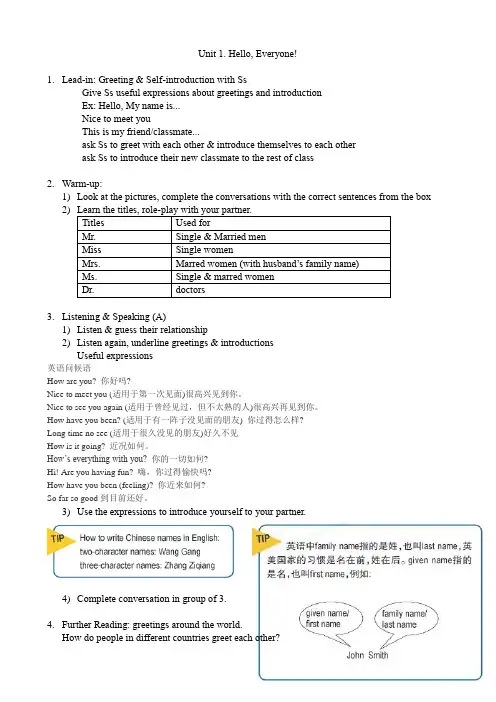
Unit 1. Hello, Everyone!1.Lead-in: Greeting & Self-introduction with SsGive Ss useful expressions about greetings and introductionEx: Hello, My name is...Nice to meet youThis is my friend/classmate...ask Ss to greet with each other & introduce themselves to each otherask Ss to introduce their new classmate to the rest of class2.Warm-up:1)Look at the pictures, complete the conversations with the correct sentences from the box2)Learn the titles, role-play with your partner.Titles Used forMr. Single & Married menMiss Single womenMrs.Marred women (with husband’s family name)Ms.Single & marred womenDr.doctors3.Listening & Speaking (A)1)Listen & guess their relationship2)Listen again, underline greetings & introductionsUseful expressions英语问候语How are you? 你好吗?Nice to meet you (适用于第一次见面)很高兴见到你。
教案〔付页〕教学内容时间教学活动评价Lesson 1: step 1 and step 2Key words:1. Lightly ad .1. 轻轻地 ,轻微地If you walk lightly, your footsteps will not be heard.如果你轻轻地走 ,别人就听不见你的脚步声了。
2.少量地 ,稍微地The cake is lightly sprinkled with sugar.蛋糕上稍许撒了些糖。
2. Bowvi.1. 顺从 ,屈服 [(+to/before)]Some people bow before money.有些人在金钱面前俯首贴耳。
1. 低(头),欠 (身)He bowed his head in shame.他惭愧地低下头来。
2.鞠躬(或欠身 )表示She bowed her thanks.她鞠躬致谢。
. 弓Believe it or not, she can draw a strong bow.你信不信由你 ,她能挽强弓。
3. Shake vt.1.摇,摇动 ;震动 ;抖动His heavy steps shook the room.他沉重的脚步使房间都为之震动。
Shake the bottle before taking the medicine.服药之前把瓶子摇一摇。
2.握(手)He came forward and shook me by the hand.他走上前来和我握手。
4. Train ]vt.1. 训练 ,培养 [O2][(+as/in/for)]The firm trained its employees to be more efficient.公司培训员工 ,使他们办事效率更高。
She was trained for nursing.她被培养成护士。
Mother trained us to be honest.母亲教育我们为人要老实。
中职英语第一册教案(全)目录UNIT 1 Greetings and Instructions (2)UNIT 2 School and Daily life (5)UNIT 3 TIME (8)UNIT4 Weather (12)Unit 5 Asking the way (15)Unit 6 Food and service (18)Unit8 Invitation (24)Unit9 Past Events (27)Unit10 Festivals and Holidays (30)UNIT 1 Greetings and Instructions一、词汇(课本14页)1. addresspostal addresspostal adj. 邮政的2. bossThis is my boss.worker3.call【教材原文】Please call me Jianjun.请叫我建军好了。
①.命名,把…叫作call sb.sthMay I have your name?call me Tom.叫我汤姆吧。
②call on sb.拜访某人call at sp.拜访某地(3)打电话call sb.(up)给某人打电话I’ll call you this evening.今晚我将给你打电话。
(4)m.电话give sb. a call 2给某人打电话make a phone call打电话This is my friend Mary (call)4. computer5. customer6. e-mail7. greet 打招呼,问好greeting n.问候(通常用复数)【教材原文】Can you greet people in English? 你会用英语打招呼吗?greet each other彼此问候、彼此打招呼We greet each other with smile.我们微笑着彼此打招呼。
中职英语第一册教案 nice to meetyouLesson 1: Nice to Meet YouAims:- To introduce basic greetings in English.- To practice introducing oneself to others.- To learn some common expressions for making introductions.- To develop listening and speaking skills.Objectives:By the end of the lesson, students should be able to:- Greet and respond to greetings in English.- Introduce themselves using basic information.- Use the expressions "Nice to meet you" and "How do you do?" - Engage in short conversations to get to know their classmates. Materials:- Whiteboard and markers.- Flashcards with different greetings and expressions.- A song or video clip with greetings and introductions. Procedure:1. Warm-up (5 minutes):- Greet the students as they enter the classroom and encourage them to respond in English.- Play a short video clip or song with greetings and introductions to get the students engaged.2. Introduction (5 minutes):- Show the flashcards with different greetings and expressions,and elicit their meanings from the students.- Practice the greetings and responses with the whole class, drilling the pronunciation.3. Introducing Oneself (15 minutes):- Model an introduction by saying "Hello, my name is [your name]." Write the sentence on the board.- Have the students practice introducing themselves in pairs, using the sentence structure.- Circulate around the classroom and provide assistance and feedback as needed.4. Expressions for Making Introductions (10 minutes):- Introduce the expressions "Nice to meet you" and "How do you do?" to the students.- Write the expressions on the board and explain their meanings. - Practice the pronunciation and intonation of the expressions as a class.- Have the students role-play introducing themselves and responding using the expressions.5. Getting to Know You (15 minutes):- Divide the class into small groups and have them sit together. - Give each group a list of questions (e.g., "What is your favorite color?" "Do you have any siblings?") to ask each other.- Encourage the students to introduce themselves and engage in conversations using the expressions they have learned.- Monitor the groups and provide assistance and feedback as needed.6. Wrap-up (5 minutes):- Gather the whole class together and ask a few students to share something interesting they learned about their classmates.- Review the greetings and expressions learned in the lesson, and give positive feedback to the students.Note: This lesson plan is based on a 45-minute class period. Adjust the timings and activities as needed to fit the length of your class.。
江苏省XY中等专业学校2022-2023-2教案编号:备课组别英语课程名称所在年级主备教师授课教师授课系部授课班级授课日期课题:Unit 1 Could I change my life?Revision教学目标1. To review the words learnt in this unit.2. To review the phrases such as "In...situation\even though\at the ageof\straight A student ..."重点1. To master the important words and the expressions for asking for and giving advice.2. To master the main contents in this part.难点How to improve the students' abilities.教法Task-based practice.教学设备Multi-media. CD.教学环节教学活动内容及组织过程个案补充教学内容Greet the class as usual.Review the words and some difficulties in theThen show the useful words and their usages on theslide.1.be addicted to sth. / doing sth. 对…上瘾Many young people are addicted to computergames.2.At the age of 15, Liz began highGreetingsRevision31/ 31。
Unit 1 Listening & SpeakingI.Warm-up1.At the beginning of the class, say hello to several students torecall the common expressions of greeting.2.Let the students complete the conversations in Activity 1 andpractice in pairs, guessing the relationship between those speakers. (Pic 1: Teacher & Student, Pic 2 : Schoolmates or Classmates, Pic 3: Mother & Daughter, Pic 4: Doctor & Patient )3.Ask the students how to address their teacher in the usual way.Then lead in the content of Activity 2, role-playing the conversation in pairs.II.Listening and SpeakingA.Nice to Meet You!1.Let the class guess the relationship between the two students inActivity 1 after listening to the record of a conversation without opening their textbooks.2.Listen to the conversation again and underline those sentencesabout greetings and introductions.3.Require the students to read the conversation after the video onesentence after another. And then make clear the main idea about the conversation. Practice the conversation in pairs.4.Brainstorming. Think about as many expressions on introducingyourself and relevant responses as possible. Then use those expressions to introduce each other in groups, referring to the short dialogue in Activity 3.plete the conversation in Activity 4 to consolidate whatyou’ve learnt about greeting and introduction. Choose some groups to act out the conversation in class.B.Let Me Introduce Myself!1.Listen to a song called My Name is Xiao Shenyang.2.Ask one student to introduce himself or herself, and then let therest think over what information they should give out when making a self-introduction.3.Talk about the different expressions between Chinese name andEnglish name.4.Go through key words in Activity 5 and finish Activity 6 & 7 bylistening to the record of the speech twice.5.Let the students guess the meaning of the girl’s name in thespeech. And then choose some students to narrate the reason of their name.6.Design a student ID of your partner by asking him or her thequestions occurring in Activity 8. Then invite some students to make a self-introduction before class according to the studentID made by their partner.7.Exercises about listening and speaking.III.Further Reading1.Brainstorming. Ask the students to list various methods ofgreeting others in other countries. If possible, make gestures to explain it clearly.2.Scan the passage in Further Reading, and choose someone toretell the main idea of the text. Try to act out each way of greeting when narrating.3.Read the whole passage after the record loudly.IV.Assignment1.Practice listening model dialogues.2.Write a short passage to introduce yourself in class.3.Preview Words and Expressions in Reading.Unit 1 Reading & WritingI.Revision1.Review model dialogues in Listening and Speaking section byasking some pairs of students to act out those dialogues in class.2.Choose some students to speak out their self-introduction infront of the class. Let the rest elect the best among them.II.Lead-in1.Ask the students to answer the question What do you like best?in order to lead in the topic of the reading passage. Name a list of things they like, such as food, books, clothes, or other things.2.By what do you address those who like food best? Let’s firstwatch a video to find out the answer. (gourmet 美食家,food lover 吃货)III.Reading1.Now we will meet such a food lover called Jenny today.Although she likes the food best, she spends her money on all aspects in a reasonable way. Then how does Jenny spend her money?Ask the students to write each category in the correct place in the pie chart after listening to the record of the text.2.Reading the passage after the record and try to find out theanswer to the questions in Activity 3.3.Learn the words and expressions related to the text. Read themfluently and try to recite them.✧spend…on 花费…在…✧go to the movie 看电影✧mobile phone 手机✧text message 短信息✧save up 储蓄,存钱4.Study the text one paragraph after another. Pay special attentionto those set phrases and key sentence patterns. Read the text together again so as to understand its theme.✧It’s great to see all of you. 见到大家很高兴。
✧I’d like to tell you a few things about myself. 我简单介绍一下自己。
✧spend some money / some time on sth. 在…上花费(时间、金钱等)✧spend some money / some time (in) doing sth. 花费(时间、金钱等)做某事✧近义词比较:sth. cost (sb.) money 某物花某人多少钱it cost (sb.) money on sth. 做某事花某人多少钱it takes sb. time (money) to do sth. =it takes time (money) for sb. todo sth. 做某事花某人多少时间(钱)sth. takes sb. time (money) to do 某事花某人多少时间(钱)去做sb. takes time (money) to do 某人花多少时间(钱)去做某事✧I also love books, especially comic books. 我也喜欢读书,尤其是漫画书。